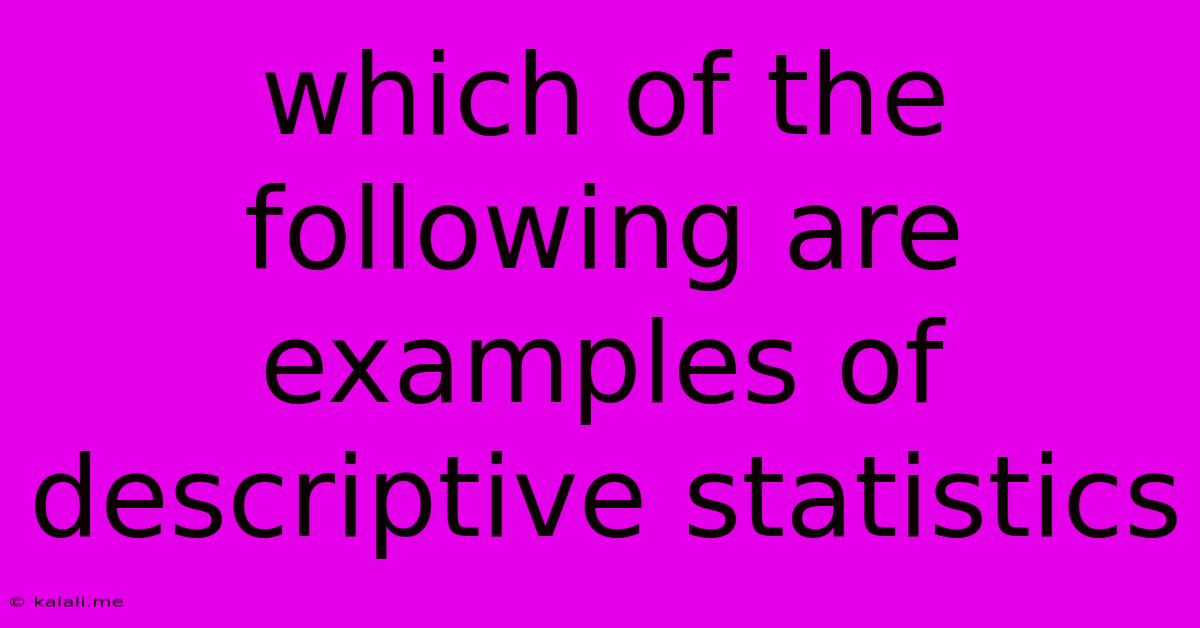Which Of The Following Are Examples Of Descriptive Statistics
Kalali
Jun 15, 2025 · 3 min read

Table of Contents
Which of the Following Are Examples of Descriptive Statistics?
Descriptive statistics are used to summarize and describe the main features of a dataset. They don't draw conclusions about a larger population, unlike inferential statistics. This article will explore various statistical measures and determine which ones fall under the umbrella of descriptive statistics. Understanding the difference between descriptive and inferential statistics is crucial for any data analysis project.
Understanding Descriptive Statistics
Descriptive statistics provide a concise summary of data, allowing for a clear understanding of its main characteristics. They help us visualize and interpret data efficiently, revealing patterns and trends. These summaries can be either numerical (e.g., mean, median, mode) or graphical (e.g., histograms, box plots, scatter plots). The key takeaway is that they describe the data itself, without making inferences about a population beyond the data you have.
Examples of Descriptive Statistics:
Let's examine some common statistical measures and categorize them:
Numerical Descriptive Statistics:
- Mean: The average of a dataset. This is a central tendency measure, giving you a sense of the "typical" value. Example: The average height of students in a class.
- Median: The middle value when a dataset is ordered. Less sensitive to outliers than the mean. Example: The median income of a neighborhood.
- Mode: The most frequent value in a dataset. Useful for categorical data. Example: The most popular color of car sold in a month.
- Range: The difference between the highest and lowest values. Shows the spread of the data. Example: The range of temperatures recorded in a week.
- Variance: Measures how spread out the data is from the mean. A higher variance indicates greater spread. Example: The variance in test scores of a class.
- Standard Deviation: The square root of the variance. Provides a more easily interpretable measure of data dispersion. Example: The standard deviation of student ages in a university.
- Percentiles: Values that divide the dataset into 100 equal parts. For example, the 25th percentile is the value below which 25% of the data falls. Example: The 90th percentile of exam scores.
- Quartiles: Specific percentiles that divide the data into four equal parts (25th, 50th, and 75th percentiles). Example: The first quartile of house prices in a city.
- Interquartile Range (IQR): The difference between the 75th and 25th percentiles. A robust measure of spread that's less sensitive to outliers than the range. Example: The IQR of daily rainfall in a region.
- Frequency Distribution: A table or graph showing the number of times each value or range of values occurs in a dataset. Example: A frequency distribution of hair colors in a population.
Graphical Descriptive Statistics:
- Histograms: Bar graphs showing the frequency distribution of a continuous variable. Example: A histogram showing the distribution of student weights.
- Box plots (Box and Whisker Plots): Display the median, quartiles, and potential outliers of a dataset. Example: A box plot comparing the exam scores of two different classes.
- Scatter plots: Show the relationship between two variables. Example: A scatter plot showing the relationship between hours studied and exam scores.
- Pie charts: Show the proportion of each category in a dataset. Example: A pie chart showing the proportion of different types of fruits sold in a market.
Measures that are NOT Descriptive Statistics:
It's important to distinguish descriptive statistics from inferential statistics. Inferential statistics use sample data to make inferences about a population. Examples include:
- Confidence intervals: Provide a range of values within which a population parameter is likely to fall.
- Hypothesis testing: Determines whether there is enough evidence to reject a null hypothesis.
- Regression analysis: Models the relationship between a dependent variable and one or more independent variables.
By understanding the characteristics of descriptive statistics and their visual counterparts, you can effectively summarize and communicate data insights. Choosing the appropriate descriptive statistic depends on the nature of your data and the questions you aim to answer. Remember to always consider the context and limitations of your chosen methods.
Latest Posts
Latest Posts
-
Washington University In St Louis Gpa Requirements
Jun 15, 2025
-
Electron Volt Is The Unit Of
Jun 15, 2025
-
Average Sat Score For Umass Amherst
Jun 15, 2025
-
Time Taken By Sunlight To Reach Earth
Jun 15, 2025
-
What Are The Miller Indices For The Plane Shown Below
Jun 15, 2025
Related Post
Thank you for visiting our website which covers about Which Of The Following Are Examples Of Descriptive Statistics . We hope the information provided has been useful to you. Feel free to contact us if you have any questions or need further assistance. See you next time and don't miss to bookmark.